
USS Voyager (SP-361) was a wooden-hulled motorboat of the United States Navy. She was built at Bay City, Michigan, by the Defoe Boat and Motor Works company, was acquired by the Navy from H. J. Defoe in July 1917.
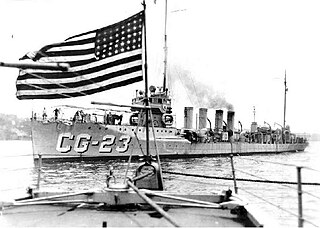
The Tucker class of destroyers was a ship class of six ships designed by and built for the United States Navy shortly before the United States entered World War I. The Tucker class was the fourth of five classes of destroyers that were known as the "thousand tonners", because they were the first U.S. destroyers over 1,000 long tons (1,016 t) displacement.

USS Teal (AM-23/AVP-5) was a Lapwing-class minesweeper acquired by the United States Navy for the task of removing naval mines from minefields laid in the water to prevent ships from passing. The ship entered service in 1918, was converted into a seaplane tender in the 1920s and took part in World War II, serving primarily in Alaskan waters. Following the war, the ship was decommissioned and sold in 1948. Teal was named after the teal, any of several small, short-necked, river ducks common to Europe and the Americas.
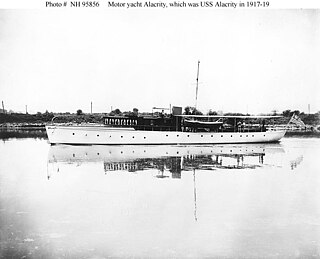
USS Alacrity (SP-206) was a steel cruising yacht that served in the US Navy as a section patrol craft. It was built by Pusey & Jones at Wilmington, Delaware for W. A. Bradford in 1910 then sold to John H. Blodgett of Boston.
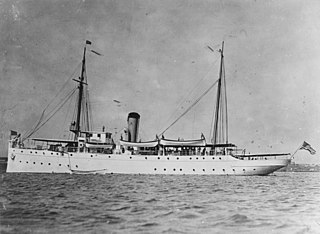
USCGC Tampa (ex-Miami) was a Miami-class cutter that initially served in the U.S. Revenue Cutter Service, followed by service in the U.S. Coast Guard and the U.S. Navy. Tampa was used extensively on the International Ice Patrol and also during the Gasparilla Carnival at Tampa, Florida and other regattas as a patrol vessel. It was sunk with the highest American naval combat casualty loss in World War I.

The second USS Suwannee and third USS Mayflower was a United States Lighthouse Board, and later United States Lighthouse Service, lighthouse tender transferred to the United States Navy in 1898 for service as an auxiliary cruiser during the Spanish–American War and from 1917 to 1919 for service as a patrol vessel during World War I. She also served the Lighthouse Board and in the Lighthouse Service as USLHT Mayflower from 1897 to 1898, from 1898 to 1917, and from 1919 to 1939, and in the United States Coast Guard as the first USCGC Mayflower (WAGL-236) in 1939 and from 1940 to 1943 and as USCGC Hydrangea (WAGL-236) from 1943 to 1945.
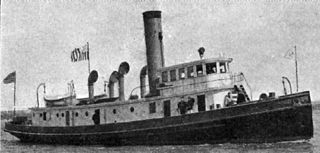
USRC Mackinac, later USCGC Mackinac, was a patrol boat that served in the United States Revenue Cutter Service from 1903 to 1915 and in the United States Coast Guard from 1915 to 1917 and from 1919 to 1939.
USCGC Patrol, later AB-38, was a United States Coast Guard patrol boat in commission from 1917 to 1918 and from 1919 to 1940. She was the second vessel of the United States Revenue Cutter Service or U.S. Coast Guard to bear the name Patrol.
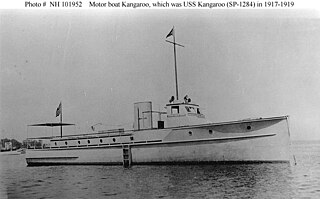
The first USS Kangaroo (SP-1284) was an armed motorboat that served in the United States Navy as a patrol vessel from 1917 to 1919.

USCGC Kangaroo, later USCGC AB-6, was United States Coast Guard patrol boat in commission from 1919 to 1932.
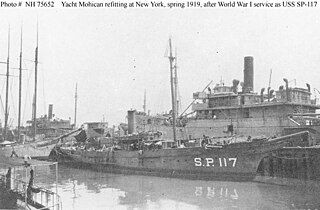
The third USS Mohican (SP-117), later USS SP-117, was an armed yacht that served in the United States Navy as a patrol vessel from 1917 to 1919.
USS Howarda (SP-144) was an armed yacht that served in the United States Navy as a patrol vessel from 1917 to 1919.

USS Apache (SP-729) was the first to be delivered of eight motor boats built by Herreshoff Manufacturing Company at Bristol, Rhode Island ordered and financed by members of the Eastern Yacht Club of Marblehead, Massachusetts. The boats were designed by Albert Loring Swasey and Nathanael Greene Herreshoff with the intention that the boats be used by the Navy as patrol craft and built with Navy approval of the design. Apache, as were the other boats, bore names under construction chosen by the owners and were then given the Section Patrol numbers on Navy acceptance and activation. The names were dropped after a period and all the boats then bore only the S.P. numbers.

The second USS Cossack (SP-695) was an armed motorboat that served in the United States Navy as a patrol vessel from 1917 to 1919.
USS Wilbert A. Edwards (SP-315), sometimes called USS W. A. Edwards, was a United States Navy patrol vessel in commission from 1917 to 1919.
USS J. A. Palmer (SP-319), later USS SP-319, was a United States Navy patrol vessel in commission between 1917 and 1919. The vessel was later USCGC Pequot in U.S. Coast Guard service.

The second USS Calumet (SP-723) was a United States Navy patrol vessel in commission from 1917 to 1919.

USS Audwin (SP-451) was a patrol vessel that served in the United States Navy from 1917 to 1919. She then was a survey vessel in the United States Coast and Geodetic Survey from 1919 to 1927.

USLHT Cedar was a lighthouse tender in commission in the fleet of the United States Lighthouse Service in 1917 and from 1919 to 1939, and – as USCGC Cedar (WAGL-207) – in the fleet of the United States Coast Guard from 1939 to 1950. She was in commissioned service in the United States Navy as the patrol vessel USS Cedar from 1917 to 1919 during and in the immediate aftermath of World War I. She also saw service in World War II under U.S. Navy control while in the Coast Guard fleet. She spent her career in the Pacific Northwest and the Territory of Alaska.

USLHT Camellia was a lighthouse tender in commission in the fleet of the United States Lighthouse Service from 1911 to 1917 and from 1919 to 1939, and – as USCGC Camellia (WAGL-206) – in the fleet of the United States Coast Guard from 1939 to 1947. During World War I she briefly saw war service with the United States Army in 1917 before serving as the United States Navy patrol vessel USS Camellia from 1917 to 1919. She also saw service in World War II under U.S. Navy control while in the Coast Guard fleet. After the conclusion of her United States Government career, she operated for decades in the service of the Dominican Navy as Capotillo.














